2008 TOYOTA HIGHLANDER HYBRID warning
[x] Cancel search: warningPage 2 of 580
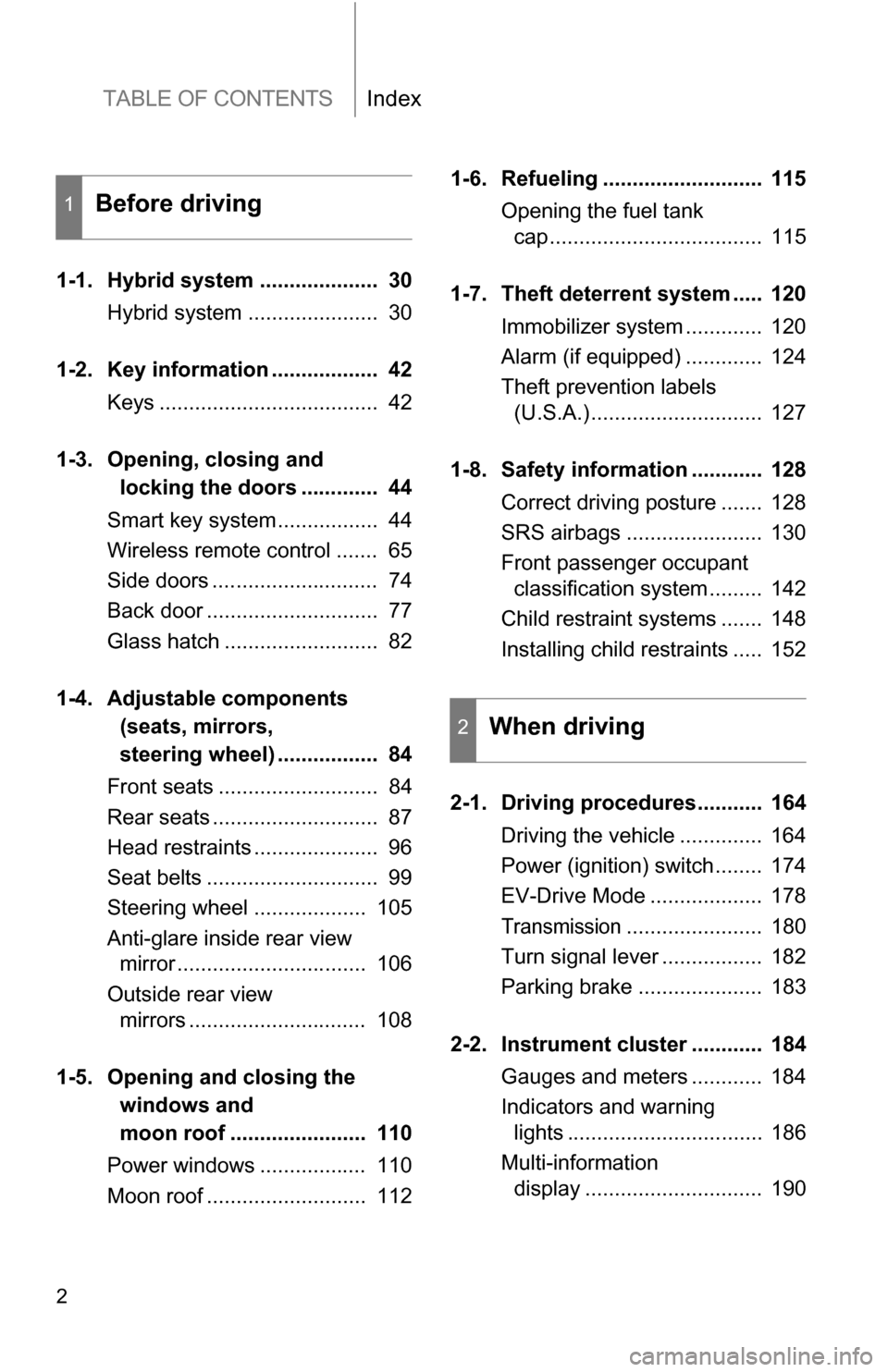
TABLE OF CONTENTSIndex
2
1-1. Hybrid system .................... 30Hybrid system ...................... 30
1-2. Key information .................. 42 Keys ..................................... 42
1-3. Opening, closing and locking the doors ............. 44
Smart key system................. 44
Wireless remote control ....... 65
Side doors ............................ 74
Back door ............................. 77
Glass hatch .......................... 82
1-4. Adjustable components (seats, mirrors,
steering wheel) ................. 84
Front seats ........................... 84
Rear seats ............................ 87
Head restraints ..................... 96
Seat belts ............................. 99
Steering wheel ................... 105
Anti-glare inside rear view mirror ................................ 106
Outside rear view mirrors .............................. 108
1-5. Opening and closing the windows and
moon roof ....................... 110
Power windows .................. 110
Moon roof ........................... 112 1-6. Refueling ........................... 115
Opening the fuel tank cap .................................... 115
1-7. Theft deterrent system ..... 120 Immobilizer system ............. 120
Alarm (if equipped) ............. 124
Theft prevention labels (U.S.A.)............................. 127
1-8. Safety information ............ 128 Correct driving posture ....... 128
SRS airbags ....................... 130
Front passenger occupant classification system ......... 142
Child restraint systems ....... 148
Installing child restraints ..... 152
2-1. Driving procedures........... 164 Driving the vehicle .............. 164
Power (ignition) switch........ 174
EV-Drive Mode ................... 178
Transmission....................... 180
Turn signal lever ................. 182
Parking brake ..................... 183
2-2. Instrument cluster ............ 184 Gauges and meters ............ 184
Indicators and warning lights ................................. 186
Multi-information display .............................. 190
1Before driving
2When driving
Page 5 of 580
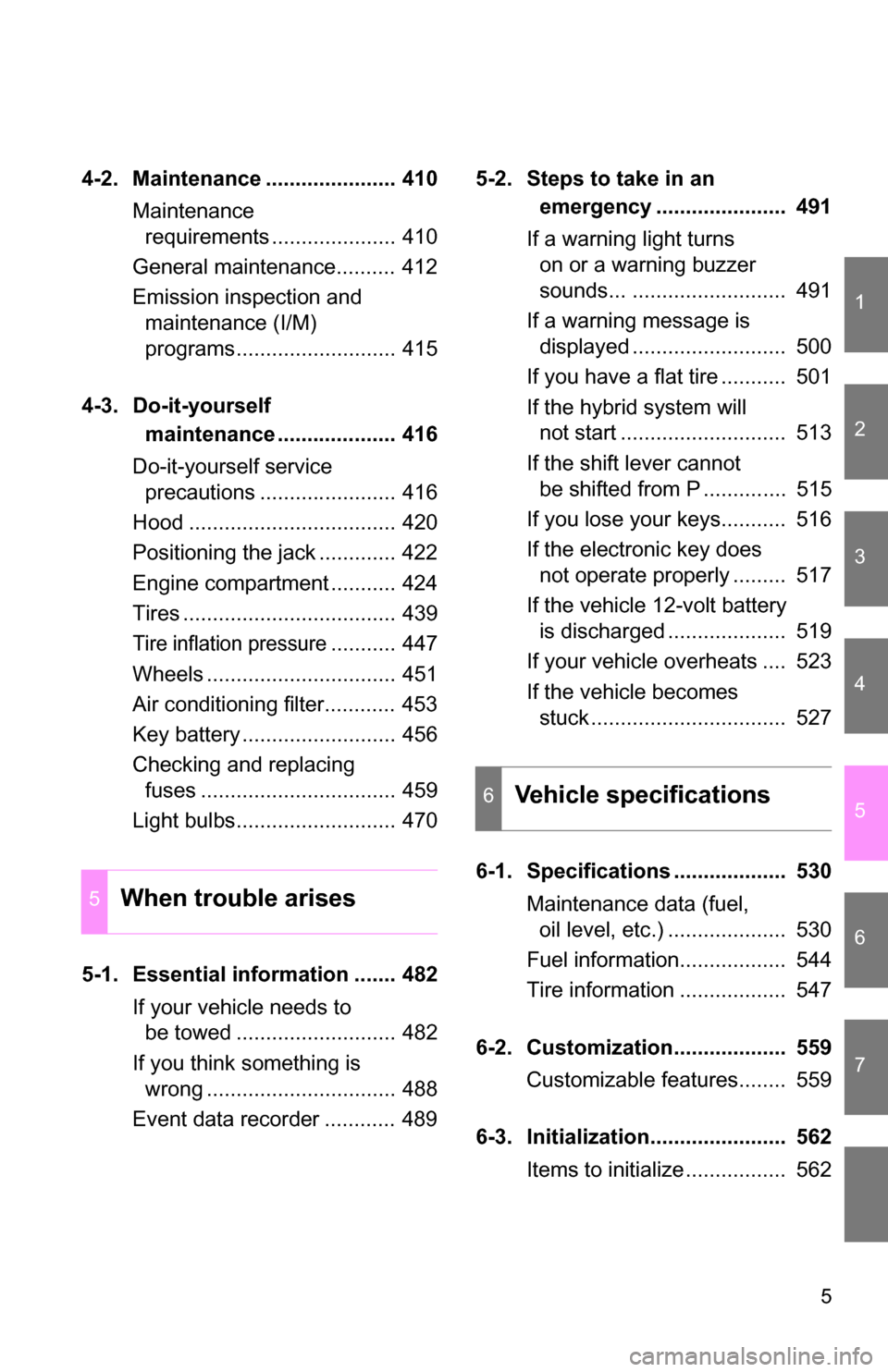
1
2
3
4
5
6
7
5
4-2. Maintenance ...................... 410Maintenance requirements ..................... 410
General maintenance.......... 412
Emission inspection and maintenance (I/M)
programs........................... 415
4-3. Do-it-yourself maintenance .................... 416
Do-it-yourself service precautions ....................... 416
Hood ................................... 420
Positioning the jack ............. 422
Engine compartment ........... 424
Tires .................................... 439
Tire inflation pressure........... 447
Wheels ................................ 451
Air conditioning filter............ 453
Key battery .......................... 456
Checking and replacing fuses ................................. 459
Light bulbs........................... 470
5-1. Essential information ....... 482 If your vehicle needs to be towed ........................... 482
If you think something is wrong ................................ 488
Event data recorder ............ 489 5-2. Steps to take in an
emergency ...................... 491
If a warning light turns on or a warning buzzer
sounds... .......................... 491
If a warning message is displayed .......................... 500
If you have a flat tire ........... 501
If the hybrid system will not start ............................ 513
If the shift lever cannot be shifted from P .............. 515
If you lose your keys........... 516
If the electronic key does not operate properly ......... 517
If the vehicle 12-volt battery is discharged .................... 519
If your vehicle overheats .... 523
If the vehicle becomes stuck ................................. 527
6-1. Specifications ................... 530 Maintenance data (fuel, oil level, etc.) .................... 530
Fuel information.................. 544
Tire information .................. 547
6-2. Customization................... 559 Customizable features........ 559
6-3. Initialization....................... 562 Items to initialize ................. 562
5When trouble arises
6Vehicle specifications
Page 27 of 580
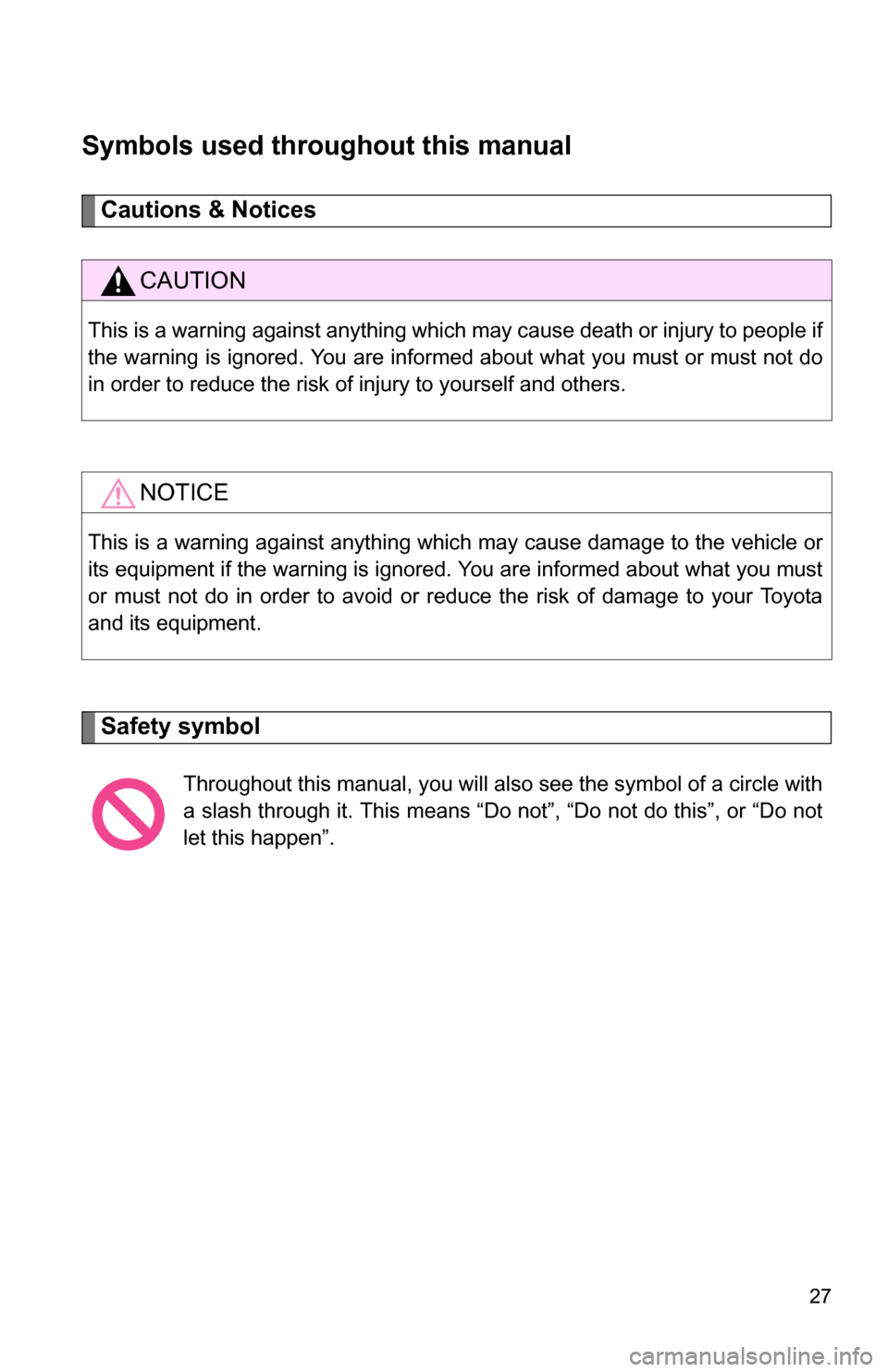
27
Symbols used throughout this manual
Cautions & Notices
Safety symbol
CAUTION
This is a warning against anything which may cause death or injury to people if
the warning is ignored. You are informed about what you must or must not do
in order to reduce the risk of injury to yourself and others.
NOTICE
This is a warning against anything which may cause damage to the vehicle or
its equipment if the warning is ignored. You are informed about what you must
or must not do in order to avoid or reduce the risk of damage to your Toyota
and its equipment.Throughout this manual, you will also see the symbol of a circle with
a slash through it. This means “Do not”, “Do not do this”, or “Do not
let this happen”.
Page 38 of 580
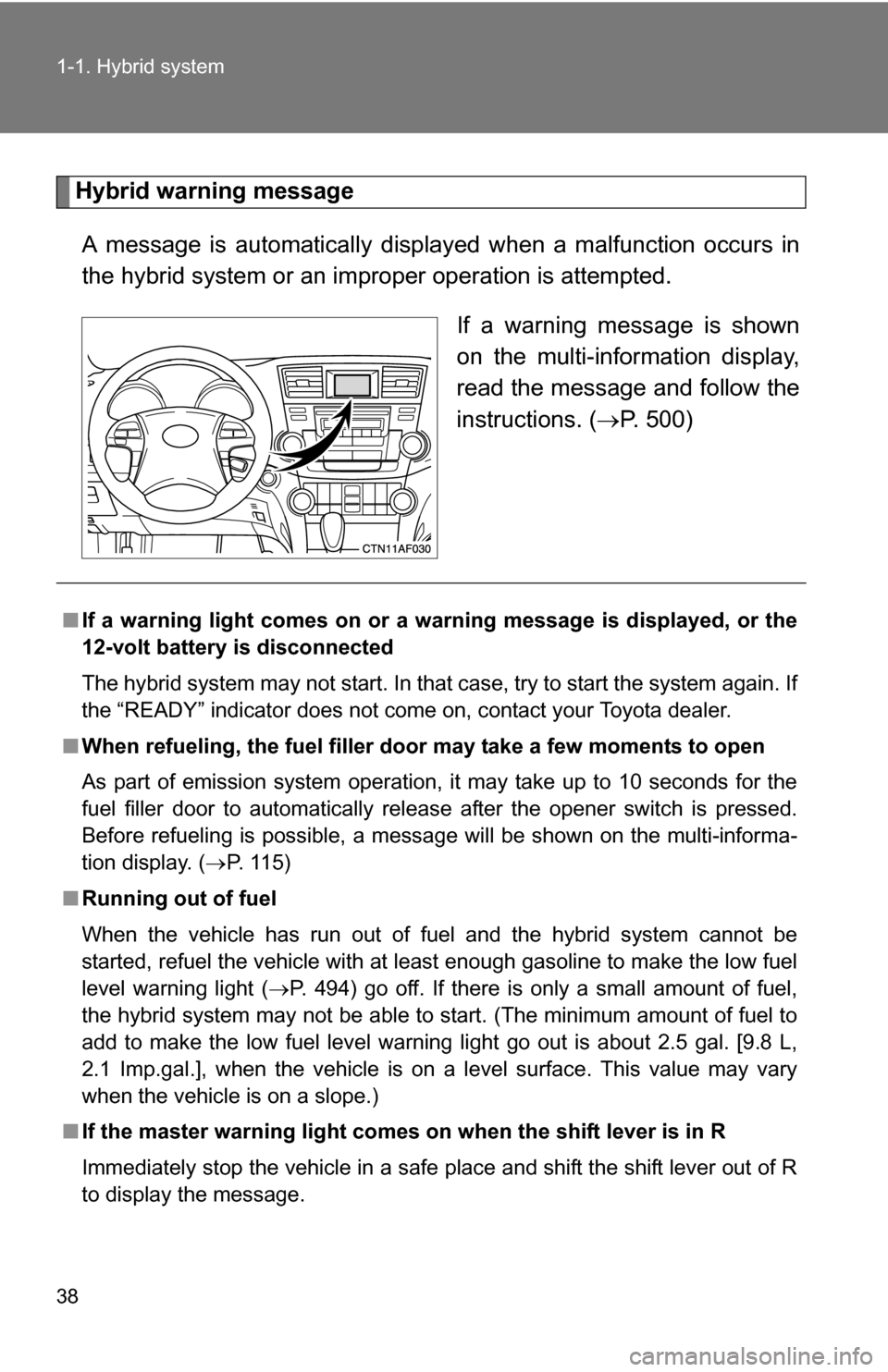
38 1-1. Hybrid system
Hybrid warning messageA message is automatically displayed when a malfunction occurs in
the hybrid system or an impr oper operation is attempted.
If a warning message is shown
on the multi-information display,
read the message and follow the
instructions. ( P. 500)
■If a warning light comes on or a wa rning message is displayed, or the
12-volt battery is disconnected
The hybrid system may not start. In that case, try to start the system again. If
the “READY” indicator does not come on, contact your Toyota dealer.
■ When refueling, the fuel filler door may take a few moments to open
As part of emission system operation, it may take up to 10 seconds for the
fuel filler door to automatically rel ease after the opener switch is pressed.
Before refueling is possible, a message will be shown on the multi-informa-
tion display. ( P. 1 1 5 )
■ Running out of fuel
When the vehicle has run out of fuel and the hybrid system cannot be
started, refuel the vehicle with at least enough gasoline to make the low fuel
level warning light ( P. 494) go off. If there is only a small amount of fuel,
the hybrid system may not be able to start. (The minimum amount of fuel to
add to make the low fuel level warning light go out is about 2.5 gal. [9.8 L,
2.1 Imp.gal.], when the vehicle is on a level surface. This value may vary
when the vehicle is on a slope.)
■ If the master warning light comes on when the shift lever is in R
Immediately stop the vehicle in a safe place and shift the shift lever out of R
to display the message.
Page 52 of 580
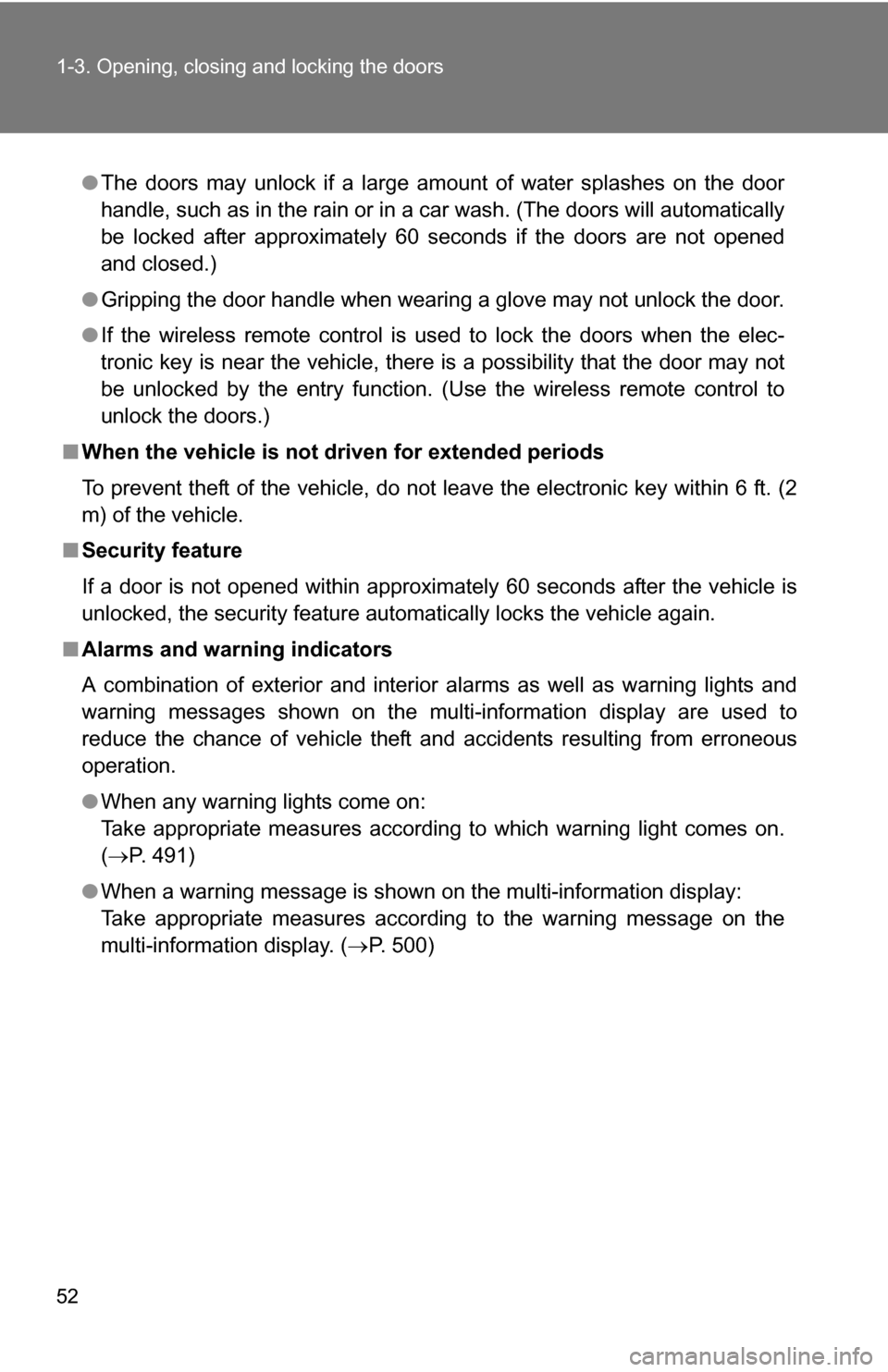
52 1-3. Opening, closing and locking the doors
●The doors may unlock if a large amount of water splashes on the door
handle, such as in the rain or in a car wash. (The doors will automatically
be locked after approximately 60 seconds if the doors are not opened
and closed.)
● Gripping the door handle when wearing a glove may not unlock the door.
● If the wireless remote control is used to lock the doors when the elec-
tronic key is near the vehicle, there is a possibility that the door may not
be unlocked by the entry function. (Use the wireless remote control to
unlock the doors.)
■ When the vehicle is not driven for extended periods
To prevent theft of the vehicle, do not leave the electronic key within 6 ft. (2
m) of the vehicle.
■ Security feature
If a door is not opened within approximately 60 seconds after the vehicle is
unlocked, the security feature automatically locks the vehicle again.
■ Alarms and warning indicators
A combination of exterior and interior alarms as well as warning lights and
warning messages shown on the multi-information display are used to
reduce the chance of vehicle theft and accidents resulting from erroneous
operation.
●When any warning lights come on:
Take appropriate measures according to which warning light comes on.
( P. 491)
● When a warning message is shown on the multi-information display:
Take appropriate measures according to the warning message on the
multi-information display. ( P. 500)
Page 55 of 580
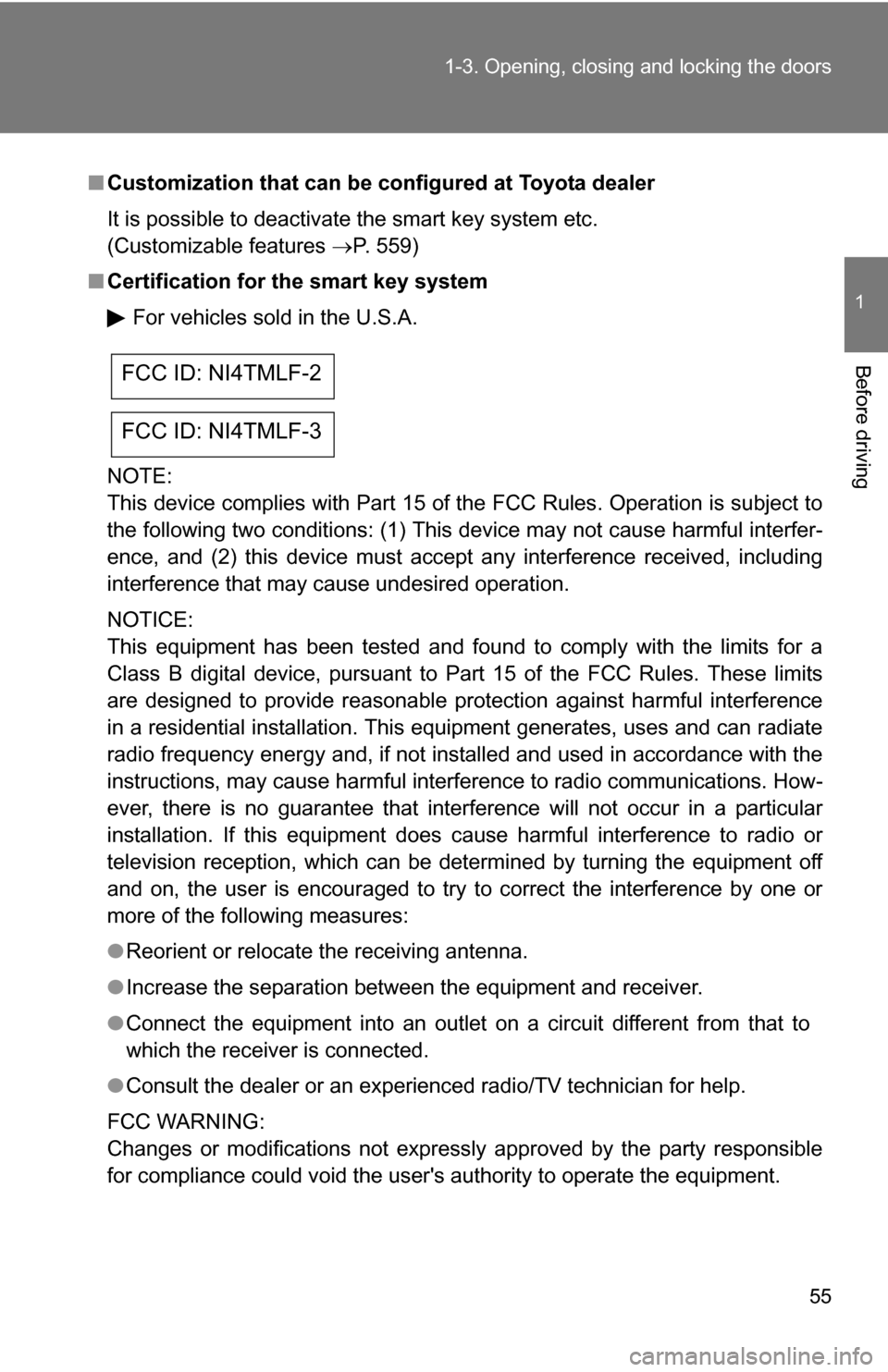
55
1-3. Opening, closing and locking the doors
1
Before driving
■
Customization that can be co nfigured at Toyota dealer
It is possible to deactivate the smart key system etc.
(Customizable features P. 559)
■ Certification for the smart key system
For vehicles sold in the U.S.A.
NOTE:
This device complies with Part 15 of the FCC Rules. Operation is subject to
the following two conditions: (1) This device may not cause harmful interfer-
ence, and (2) this device must accept any interference received, including
interference that may cause undesired operation.
NOTICE:
This equipment has been tested and found to comply with the limits for a
Class B digital device, pursuant to Part 15 of the FCC Rules. These limits
are designed to provide reasonable protection against harmful interference
in a residential installation. This equipment generates, uses and can radiate
radio frequency energy and, if not installed and used in accordance with the
instructions, may cause harmful interference to radio communications. How-
ever, there is no guarantee that interference will not occur in a particular
installation. If this equipment does cause harmful interference to radio or
television reception, which can be determined by turning the equipment off
and on, the user is encouraged to try to correct the interference by one or
more of the following measures:
● Reorient or relocate the receiving antenna.
● Increase the separation between the equipment and receiver.
● Connect the equipment into an outlet on a circuit different from that to
which the receiver is connected.
● Consult the dealer or an experienced radio/TV technician for help.
FCC WARNING:
Changes or modifications not expressly approved by the party responsible
for compliance could void the user's authority to operate the equipment.
FCC ID: NI4TMLF-2
FCC ID: NI4TMLF-3
Page 67 of 580
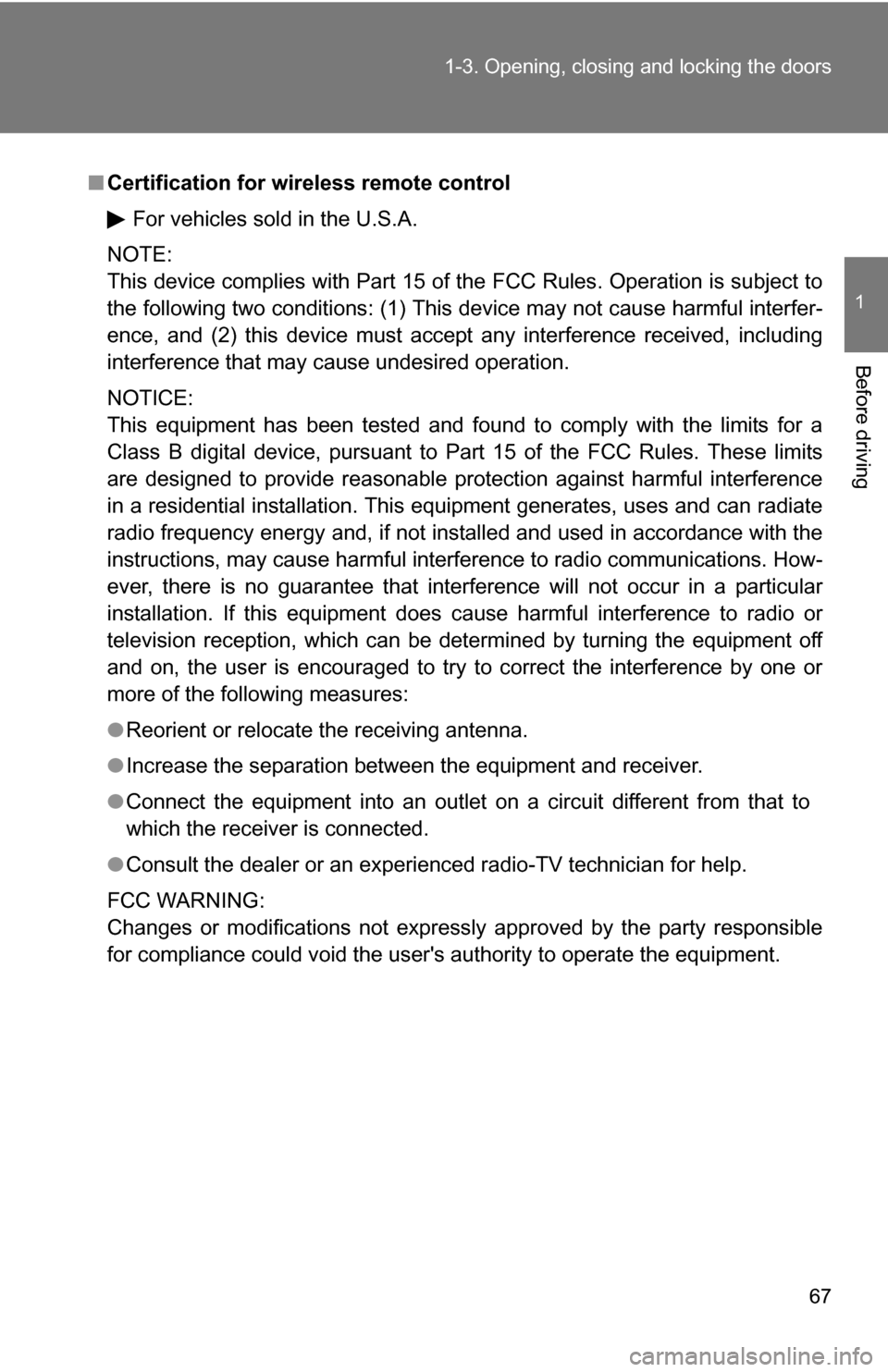
67
1-3. Opening, closing and locking the doors
1
Before driving
■
Certification for wireless remote control
For vehicles sold in the U.S.A.
NOTE:
This device complies with Part 15 of the FCC Rules. Operation is subject to
the following two conditions: (1) This device may not cause harmful interfer-
ence, and (2) this device must accept any interference received, including
interference that may cause undesired operation.
NOTICE:
This equipment has been tested and found to comply with the limits for a
Class B digital device, pursuant to Part 15 of the FCC Rules. These limits
are designed to provide reasonable protection against harmful interference
in a residential installation. This equipment generates, uses and can radiate
radio frequency energy and, if not installed and used in accordance with the
instructions, may cause harmful interference to radio communications. How-
ever, there is no guarantee that interference will not occur in a particular
installation. If this equipment does cause harmful interference to radio or
television reception, which can be determined by turning the equipment off
and on, the user is encouraged to try to correct the interference by one or
more of the following measures:
● Reorient or relocate the receiving antenna.
● Increase the separation between the equipment and receiver.
● Connect the equipment into an outlet on a circuit different from that to
which the receiver is connected.
● Consult the dealer or an experienced radio-TV technician for help.
FCC WARNING:
Changes or modifications not expressly approved by the party responsible
for compliance could void the user's authority to operate the equipment.
Page 121 of 580
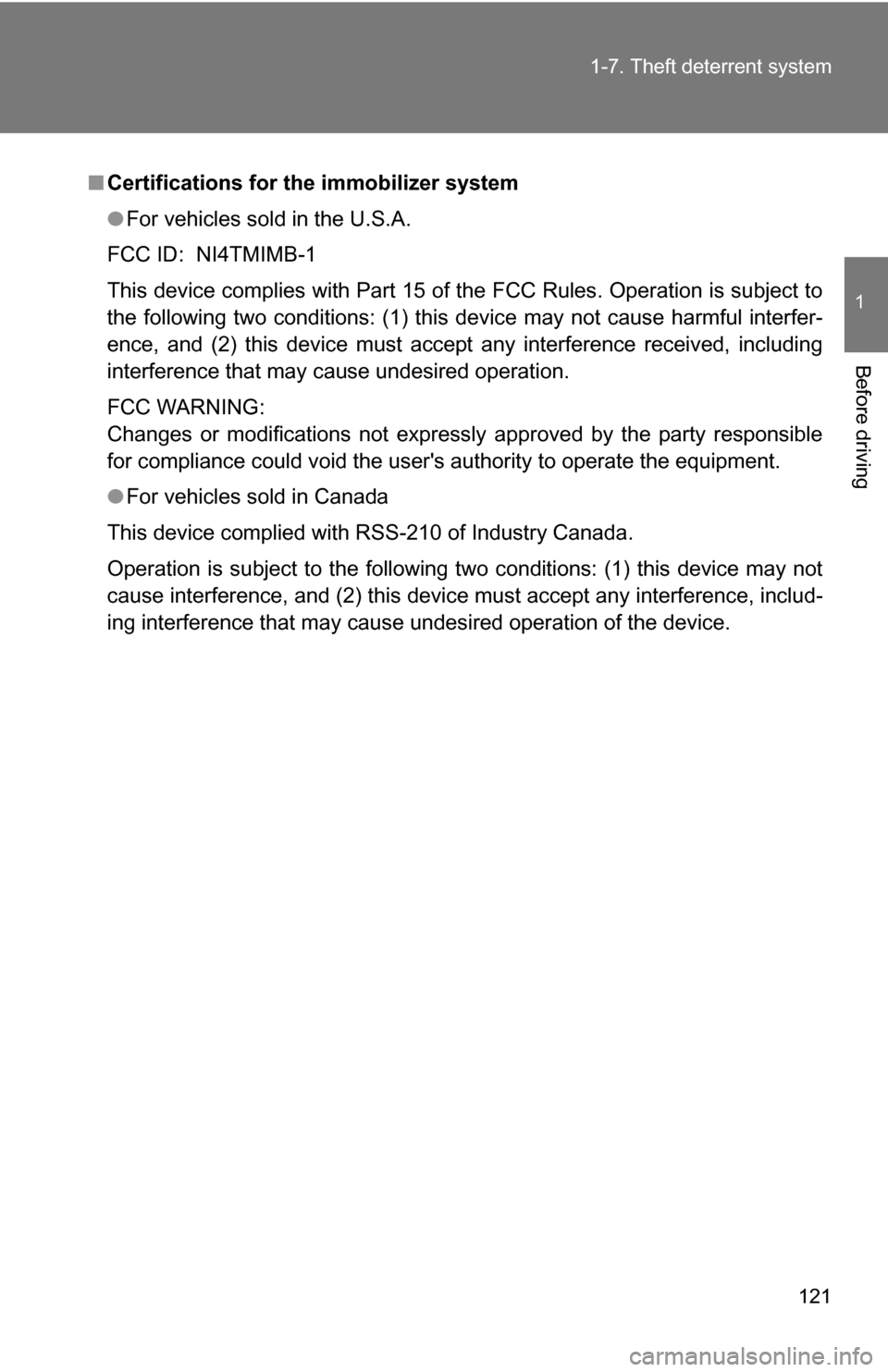
121
1-7. Theft deterrent system
1
Before driving
■
Certifications for the immobilizer system
●For vehicles sold in the U.S.A.
FCC ID: NI4TMIMB-1
This device complies with Part 15 of the FCC Rules. Operation is subject to
the following two conditions: (1) this device may not cause harmful interfer-
ence, and (2) this device must accept any interference received, including
interference that may cause undesired operation.
FCC WARNING:
Changes or modifications not expressly approved by the party responsible
for compliance could void the user's authority to operate the equipment.
● For vehicles sold in Canada
This device complied with RSS-210 of Industry Canada.
Operation is subject to the following two conditions: (1) this device may not
cause interference, and (2) this device must accept any interference, includ-
ing interference that may cause undesired operation of the device.